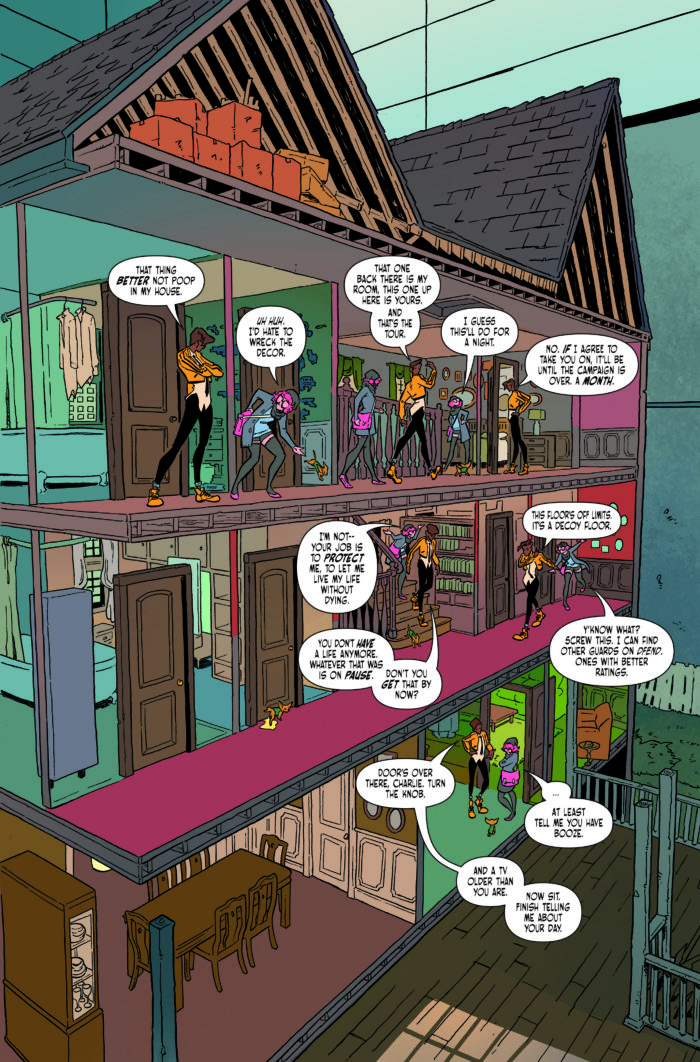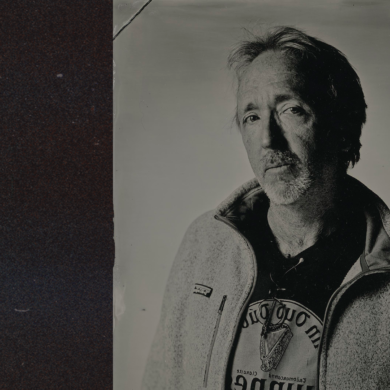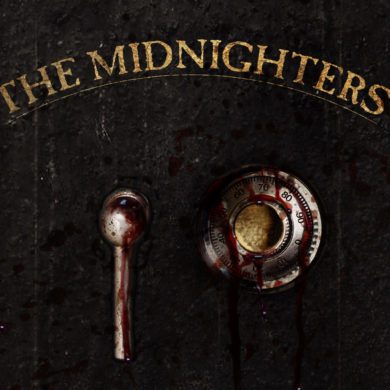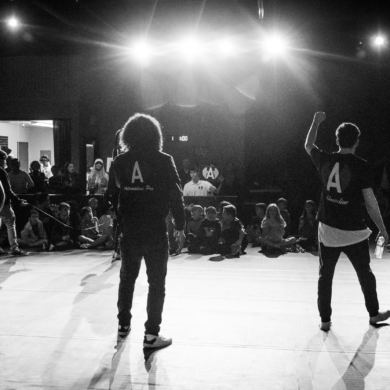By Justin Sanders
With their expressive visuals and cartoony speech bubbles, comic books offer the breeziest of reading pleasures, even when the material is dark or heavy. But don’t mistake “breezy” for “easy.”
In their acclaimed comic book series, Crowded, the self-described, British-born “comics line art duo” of Ro Stein and Ted Brandt flex an illustrative panache so breezy you could sail on it as they bring to life the sci-fi tale of a plucky young woman mysteriously targeted by a crowdfunded assassination campaign.
It’s a potentially pretty dark story that Stein and Brandt help make absolutely delightful to read, with an exuberant drawing style that helps it all go down like soda pop. But the comic’s fizzy smoothness belies an enormous amount of effort behind the scenes.
The duo spend all day every day hunched over an iPad or drawing table, clutching their implements of choice as they design, choreograph, draw, and polish panel after panel after panel. A single page can take up to three days to complete, and the average issue runs 24 pages. Setbacks are frequent and hazards arise that they could never have predicted. Last summer, for instance, Brandt got a repetitive strain injury in his hand when a heatwave kept drying the ink on the end of his nib, forcing him to re-dip at a far higher rate than usual.
They make a living from all this effort, but it’s far from luxurious. Crowded is beloved by critics, but hardly a bestseller. That’s why it stung so much when Brandt recently discovered a comic book piracy website where their beloved creation had been stolen more than 95,000 times. If even a fraction of those illegal reads were converted to sales, it would have made a huge difference in their income for the year.
“I was like, ‘Holy s**t,’” Brandt told CreativeFuture, reliving the incident during a recent interview. It was the droll capstone on an enlightening conversation with both artists that touched on everything from 3D modeling in comics to the dangers of signing with the wrong illustration agency…
JS: Together, you form what you call a “comics line art duo.” Let’s break that down. Ted, you are an inker of comic books, and you, Ro, you are a penciller. What does each job entail?
RS: The job of the penciller is to take the script and create the visual language of the page. The pencils aren’t finished art, but they define choreography of the page, as well as body language, expression, space, form, lighting and pacing.
TB: My job is to make finished line work, to take all the stuff that Ro’s put onto the page and unify it, make it consistent, fix things, or develop things further so that it becomes print-ready. For instance, while Ro has gotten quite good at arm shaping, she’s still a little bit hesitant on the muscles. So, I’ll go in and add in muscle tone where it’s needed or make small alterations.
JS: How did you settle into these roles?
TB: It was a fairly obvious split, really. I am better at fixing things, and Ro is better at creating them. Ro is better at putting things together, but also messier than I am.
RS: I am so messy.
JS: Let’s talk about process. How do you begin illustrating a comic together?
TB: We work out the layouts for the pages together, which is kind of establishing the visual “choreography” of the panels. We work out how big each panel is going to be, and what angles each image will be, and that sort of stuff. That’s the layout stage.
JS: Let’s see this in action. I’m looking at the first issue of Crowded, which has a really cool page featuring the home of one of the main characters, Vita. You have chosen to devote an entire page to an illustration of the house, opening it up like a diorama so we can look into its interior. How did you decide on this layout approach to introduce us to the house?
RS: The writer of Crowded, Christopher Sebela, wanted to have a kind of doll’s house motif to depict Vita’s house.
TB: Choosing to open it up from a three-quarter angle, rather than front on, was purely a practicality issue – so that we could get the most visual information in.
That was quite the project, that house, because we built the whole thing in a 3D modeling program called Sketchup, from the ground up – up to and including all the joists in it, standard thicknesses of floors, and what sort of beam length and type they would have been constructing with for this style of house.

JS: When I think about illustrating comics, I don’t picture using a 3D modeling program. Do you use Sketchup regularly?
RS: Yes. Once we have the layouts, I will begin by making “sets” in Sketchup for each scene. It’s mostly for consistency because there are a lot of scenes that will happen in the same room or setting over and over again. Using these sets, I can get the “shots” for each scene figured out from the layouts we’ve done, then get screen shots of them to put into pages that are in a drawing program called Clip Studio.
JS: Then what happens?
RS: Then I will figure out the body language and designs for the characters who are going to occupy those pages, and draw them into the background, and develop, from the screen shots, the backgrounds for the pencils.
We then print those digital drawings out in a very pale blue, so, even though they were digitally rendered, it looks as though they’ve been done in pencil. Ted then works over them using actual, traditional pen and ink.
TB: Once my part is done, we scan those inked pages and I run them through Photoshop to filter out all of the blue and turn the drawings into solid, black line works. Then our work is done, and the finished drawings get sent off to a colorist.
JS: That’s such an interesting merging of digital and traditional techniques. How long does it take to complete one issue of Crowded?
TB: You’re looking at about six to eight weeks. For a standard, 20-page superhero comic, you can expect about four weeks for what we do – line art, pencils, and inks. But Crowded issues are about four pages longer on average, and much denser. The average panel count for a superhero comic is 100 panels per issue. For Crowded, it’s around 200.
JS: Why is it so much denser?
TB: The writer, Chris, has a very dense storytelling style. Sometimes there are so many people doing something in one of his panels, some of them need to be siphoned off into their own panels to make it clearer. Or sometimes he writes it a bit like a movie screenplay. He’ll be describing a big action from a character and there’s not necessarily a clear way to represent that in one panel, so we might split that up into several panels to make it easier to follow.
JS: When did you two start working together?
TB: We were in the same class at university for a while, then dating by the final year, but we didn’t start working together until two years after we had finished school. I saw a job posting on Tumblr of all places, from Jeremy Whitley, writer of the Princeless comic book series. His original artist was experiencing some personal issues that had forced him to drop out and they needed a fill-in. We realized that neither one of us was fast enough to illustrate a comic for print, with multiple issues, on our own. That was when we decided to try doing it together.
JS: What is Princeless about?
TB: Jeremy started writing Princeless for his daughter because he was worried that comics weren’t offering a lot of strong female protagonists for girls her age. Princeless is about a black princess called Adrian who is the middle child. As per her family tradition, she has been locked in a tower to await a prince. But instead of waiting, she teams up with the dragon who is guarding her, breaks out of the tower, and goes off rescuing her sisters so they don’t have to wait for anyone either. It’s a great series for kids.
JS: Did you know Jeremy before getting the job?
TB: Not at all. I had been following him on Tumblr for a while, but that was it really. We didn’t even have any proper samples to send in. None of our comics were particularly relevant at that time. We ended up just sending in a bunch of stuff that we had lying around.
RS: And we did some character designs specific to the series.
TB: Yeah, I think that’s what got us the job. Jeremy told us later that we were the only ones who explicitly said, “Could we have a script to do some sample pages and show you what we can do?” That seemed to be enough to convince him we would probably be a good bet.
JS: What sorts of comics had you been working on prior to that? Did you have a particular niche or genre you were aiming for?
RS: [Laughs] Not really.
TB: Our body of work was… eclectic. We hadn’t made any comics at all since university. We both had signed with this disastrous illustration agency, who had promised that they would help us develop work and that most of their illustrators worked full-time, and all that. Well, in 18 months they got each of us exactly one job – which wasn’t very big. Only after we had finally extricated ourselves from them, were we able to pursue jobs like Princeless.
JS: Was it hard diving full-on into an established comic book after such a long period of relative inactivity?
TB: It was definitely a very intense learning experience. The initial job was artwork for four 24-page issues – the longest project by far that either of us had done.
RS: [Laughs] I’m certain that volume of pages was more than the three years of university work I’d done combined.
TB: In school, I produced the most output in our class – certainly not the best but the most – and I made about 60-70 pages of finished comic by the end of a two-year program. Princeless was 96 pages – and we had about six months to do it. It was very low-detail work that now we could turn out quite quickly, but the learning curve at that time was very steep.
JS: How did Crowded come about?
TB: Desperation, largely [laughs]. We had been doing work for Marvel in a sort of on and off capacity, doing short-order Avengers jobs. If they needed a hand, we’d pop in and knock out an issue and then fade away again.
And it was fine. The pay is pretty good – certainly the best pay we’ve had in comics – and the deadlines were mostly survivable. But the problem with that sort of work is that there came a day when they just didn’t need anything else from us, and we started to get a bit worried.
I was talking to someone I knew, who is now the editor on Crowded, and I was saying, “I’m getting really worried now. It’s been a couple of months and we haven’t had any income.”
RS: And she said, “My friend Chris is looking for artists to pitch stuff with. Let me put him in touch with you.”
TB: So, we had a Skype chat with Chris where he outlined five potential projects.
RS: Crowded was the second one he brought up, and we were like, “That’s the one we want to do.”
JS: So, you helped him develop the idea – does that mean you guys co-own the rights to the book with Christopher Sebela?
TB: Chris was the guy with the initial idea, and he was the one who pitched it to Image and is their first point of contact. But it was pitched as a full-team effort and each of us working on it owns a chunk of the book. There’s the three of us – Chris, Ro, and myself – and then we’ve got an absolutely incredible colorist, Trina Farrell. Then there’s our letterer, Cardinal Rae, who also does a brilliant job for us.
JS: There are multiple creative minds behind every comic book, whose livelihoods are supported by its sales. Something to keep in mind when buying comics or, on the flipside, choosing to steal them. Ted, you yourself recently posted a rather shocking tweet about Crowded’s piracy data. What happened there?
TB: A comics journalist did a twitter poll asking, “How many times do you think your book has been pirated?” along with some data on the topic. I asked him what site he was getting his information from – when I went and had a look, I was like, “Holy shit.”
Over its first 10 issues, Crowded had 95,000 pirated reads.
RS: We were expecting a couple of thousand at most.
JS: Your tweet was picked up by the blog Geeks WorldWide, who did the math on how much money that amounts to losing – $370,000. That seems like a lot.
TB: I’m assuming by now, since that article ran, that the number of pirated reads is at least at 100,000 copies on that one site alone. So, at a conservative estimate, we could round it up to $400,000 in lost sales – that would mean $200,000 dollars to the retailer and $200,000 back to our publisher, Image. Image would have collectively taken their due, and then something in the low six figures would have come to the team, to us.
JS: For a lot of artists, that kind of money can be a real difference-maker.
TB: That’s just the start of it. My understanding is that there are somewhere between three and five major sites at any given time where known comics can be pirated in significant numbers. We could probably assume that if there are 100,000 pirated views on the site mentioned, that there are probably in the range of 300,000-500,000 overall, across all the top sites.
JS: You asked in your tweet if anyone knew how to get their works off these comic book piracy sites. Did you get any responses?
TB: Yes, and basically you have to pay to do it. You have to pay $50 per issue to get it registered as belonging to us. So that would be $500 just for the registering, then we’d have had to take that information and pay to effectively litigate the site. It would be a logistical nightmare.
We’ve shown the piracy sites the copyrights and said, “These belong to us, take them down,” and they just wouldn’t listen. Why would they? They’re registered with fake names and often outside of the US. So, the short answer is, “Good luck, you can’t stop the piracy.”
JS: That is really depressing. Let’s try to end on an upbeat note. What advice would you have for someone who, even after reading about these dismal piracy numbers, wants to pursue comic book illustration as a career?
RS: Have a safety net when you’re starting out.
TB: Yes. There is no shame in working a job and trying to break into comics around that. A lot of people I’ve spoken to over the years have been like, “You know, I’ve been thinking about just ending my job soon and going into comics.” And I’m like, “No. Don’t do that.”
But besides making sure you’re financially stable, my advice would be to learn storytelling – for comics specifically. It doesn’t matter how well you can draw a single image, or how well you can write prose, comics is a very different beast, with a brand of pacing and storytelling all its own. No matter how good all your technical skills are that seem related, you will make a bad comic without an understanding of storytelling in comics. Pretty but hard to read is your best-case scenario without storytelling ability.
And, if anyone reading this is interested in talking more about this career, my DMs on Twitter are always open to people who are new to this craft and want advice!





